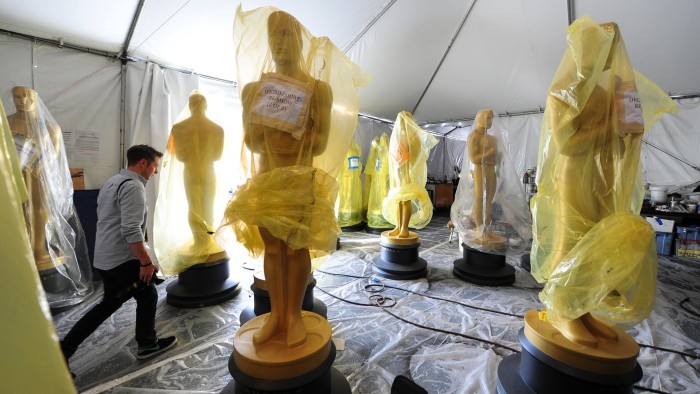How Indiewood gatecrashed the Oscars

Simply sign up to the Life & Arts myFT Digest -- delivered directly to your inbox.
Oscars: the very name conjures a world of high glamour, big budgets and box-office gold. And for much of the Academy Awards’ history, this has been the reality. In the decade following The Bridge on the River Kwai’s triumph in 1957, half of the films to win Best Picture were also the highest earners of their respective years. Titanic, which won 11 Oscars in 1997, had a budget of $200m; it was, at the time, the most expensive film ever made and the highest grossing.
But the past few years have been different. Since the third Lord of the Rings film in 2003, no Best Picture winner has broken into the year’s box office top 10. Richard Linklater’s much-admired Boyhoodwas made for just $4m, but following its wins at the Golden Globes and the Baftas is now widely considered to be this year’s frontrunner for Best Picture. If it wins it will be — adjusting for inflation — the lowest-budget winner in the Oscars’ 87-year history. Damien Chazelle’s Whiplash, though less likely to win, was made for even less at $3.3m.
From the gruelling Winter’s Bone to the magic-realist Beasts of the Southern Wild, independent films have peppered recent Best Picture races. As a result, formerly niche directors are becoming household names. Wes Anderson’s highly stylised Grand Budapest Hotel, made for a relatively modest $30m, took an exceptional $175m at the box office and has nine Oscar nominations while Richard Linklater has secured his first Best Picture nomination 24 years after his debut, the generation-defining Slacker.
Big stars, meanwhile, are conspicuously tying themselves to smaller projects. Matthew McConaughey, who made his screen debut in Linklater’s 1993 Dazed and Confused, has moved away from the mainstream, returning to his indie roots as the shrivelled protagonist of Dallas Buyers Club last year. Patricia Arquette took a hefty pay cut to appear in Boyhood. And in January, Kristen Stewart became the first US actress in 30 years to be nominated for a César award for Olivier Assayas’s Clouds of Sils Maria, two years after starring in the final instalment of The Twilight Saga. “It’s a little bit like the plot of Birdman, but instead of going into the theatre, the actors are doing these indie films,” says Peter Biskind, film historian and author of Easy Riders, Raging Bulls.
Partly this is the legacy of a movement pioneered in the early 1990s by the Weinstein brothers’ Miramax, which championed complex, character-driven films of the kind that weren’t represented in Hollywood. By putting money behind young artists such as Quentin Tarantino, Miramax began to bridge the gap between the mainstream and the fringe to create what was later dubbed “Indiewood”. The contemporary equivalent is Annapurna Pictures, founded by Californian heiress Megan Ellison, which acts as a kind of angel investor for mid-budget films. Foxcatcher, another Best Picture contender, is one of them.
Also during the 1990s, Robert Redford’s Sundance Film Festival began to throw up films that attracted the attention of producers and led to distribution deals. In the decades since, the festival has flourished: 45,000 people visited Park City, Utah for Sundance last year, and 95 of the 184 films screened there were bought by distributors. If Boyhood takes the Best Picture Oscar, it will be the first winner ever to have premiered at Sundance.
This year’s list of Best Picture nominees is diverse, flecked with tricky films that probe issues that still itch America, such as race and foreign policy. Others question the very state of American cinema — Birdman is a barely disguised attack on the superhero genre while Boyhood is a grand experiment that redraws rules on form and structure. Today’s indies may lack what he calls “that ragged, first-film quality” of 1960s independent films such as Easy Rider but they still have little in common with Titanic.
It makes sense that the Indiewood movement be gaining traction at the highest level now, at a time when Hollywood is in the grip of the most expansive franchising boom in its history. Cinemagoers are suffering what Biskind refers to as “superhero fatigue”, and the indie movement, he says, “has taken on a life of its own, partly thanks to the fact that Hollywood is slitting its own throat”. Studios are led by non-creative executives (the current CEO of Warner Bros, Kevin Tsujihara, started out managing Six Flags theme parks for Time Warner and has never produced a film) and line up sequels like Ford Model Ts (Avengers: Infinity War — Part II is scheduled for 2019). This overwhelmingly commercial approach is pushing audience attention in the opposite direction.
But as indies move into the mainstream, they are, by definition, no longer really indies. They are not, as Biskind describes them, “anything Hollywood is not”. There may be directors at today’s Oscars who got their breaks at Sundance, but they often employ big stars to get their films financed and their production companies are often subdivisions of big studios — Fox Searchlight and Sony Pictures Classics funded almost half of this year’s Best Picture list.
What we perceive as “indie” has been sanitised for broader consumption, attenuated in style and subject matter since the days of Slacker and Reservoir Dogs. “There’s some upheaval coming from the bottom,” says Biskind. “But you have to understand that the bottom is really the old middle. It’s pretty conventional.”
Comments